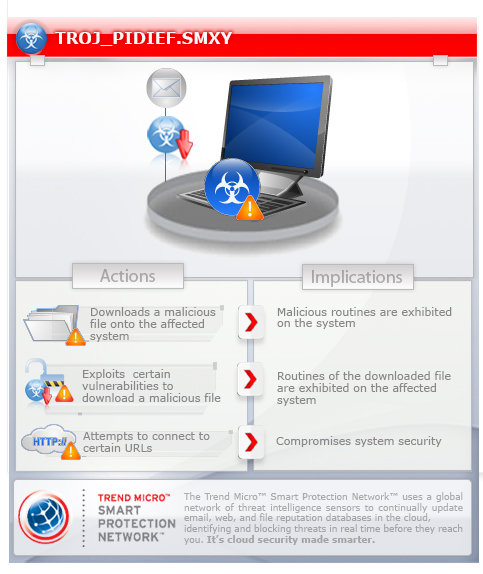TROJ_PIDIEF.SMXY
Exploit:Win32/Pdfjsc.AGF(Microsoft), PDF:Exploit.PDF-JS.UX(Bitdefender), JS/Exploit.Pdfka.QCR trojan(Eset)
Windows 2000, Windows Server 2003, Windows XP (32-bit, 64-bit), Windows Vista (32-bit, 64-bit), Windows 7 (32-bit, 64-bit)


Threat Type: Trojan
Destructiveness: No
Encrypted: Yes
In the wild: Yes
OVERVIEW
This malware was involved in a malicious spam attack targeting Walmart customers on May 2013. It takes advantage of certain vulnerabilities to download and execute malware onto affected systems, causing malicious routines to be exhibited.
To get a one-glance comprehensive view of the behavior of this Trojan, refer to the Threat Diagram shown below.

This Trojan arrives as an attachment to email messages spammed by other malware/grayware or malicious users. It arrives on a system as a file dropped by other malware or as a file downloaded unknowingly by users when visiting malicious sites.
TECHNICAL DETAILS
Arrival Details
This Trojan arrives as an attachment to email messages spammed by other malware/grayware or malicious users.
It arrives on a system as a file dropped by other malware or as a file downloaded unknowingly by users when visiting malicious sites.
Download Routine
This Trojan connects to the following website(s) to download and execute a malicious file:
- http://{BLOCKED}.{BLOCKED}.169.204/57b1bcef1c6bf783f98ccc1f684b7543/57b1bcef1c6bf783f98ccc1f684b7543/q.php?apzxy=1o:1f:1o:1m:31&jawnyeh=1g:1n:32:33:1n:1n:1n:2v:31:1o&khppmnx=1h&zbigrn=xntcs&fdiprc=coyhlfog
It takes advantage of the following software vulnerabilities to download possibly malicious files:
After successfully exploiting the said vulnerability, this malware connects to the following URLs to possibly download other malicious files:
- ip-217-137.{BLOCKED}ub.biz
It saves the files it downloads using the following names:
- %User Temp%\wpbt0.dll
(Note: %User Temp% is the current user's Temp folder, which is usually C:\Documents and Settings\{user name}\Local Settings\Temp on Windows 2000, XP, and Server 2003, or C:\Users\{user name}\AppData\Local\Temp on Windows Vista and 7.)
SOLUTION
Step 1
Before doing any scans, Windows XP, Windows Vista, and Windows 7 users must disable System Restore to allow full scanning of their computers.
Step 2
Restart in Safe Mode
Step 3
Search and delete this file
- %User Temp%\wpbto.dll
Step 4
Restart in normal mode and scan your computer with your Trend Micro product for files detected as TROJ_PIDIEF.SMXY. If the detected files have already been cleaned, deleted, or quarantined by your Trend Micro product, no further step is required. You may opt to simply delete the quarantined files. Please check this Knowledge Base page for more information.
Step 5
Download and apply this security patch Refrain from using these products until the appropriate patches have been installed. Trend Micro advises users to download critical patches upon release by vendors.
Did this description help? Tell us how we did.

